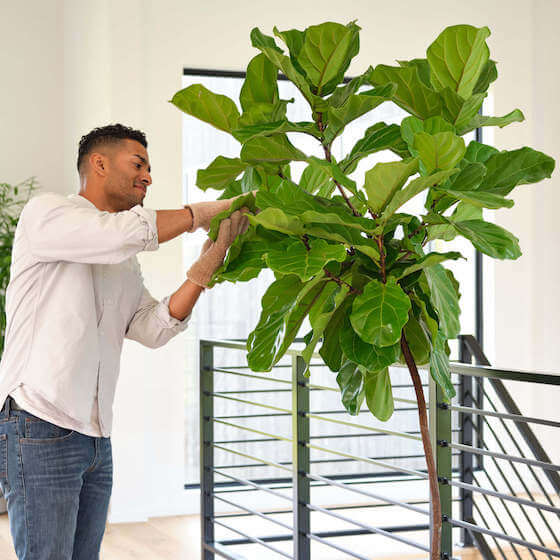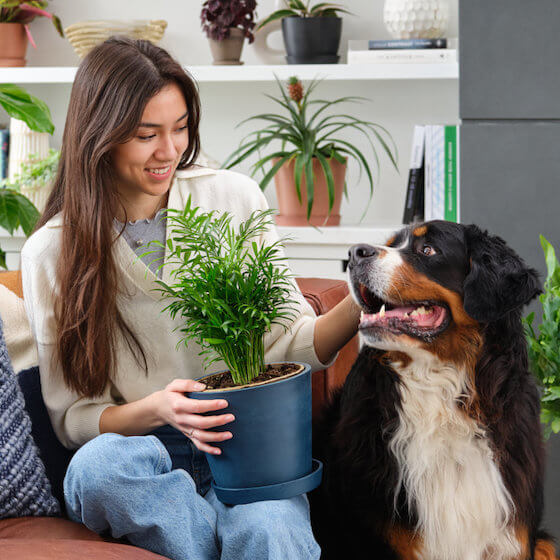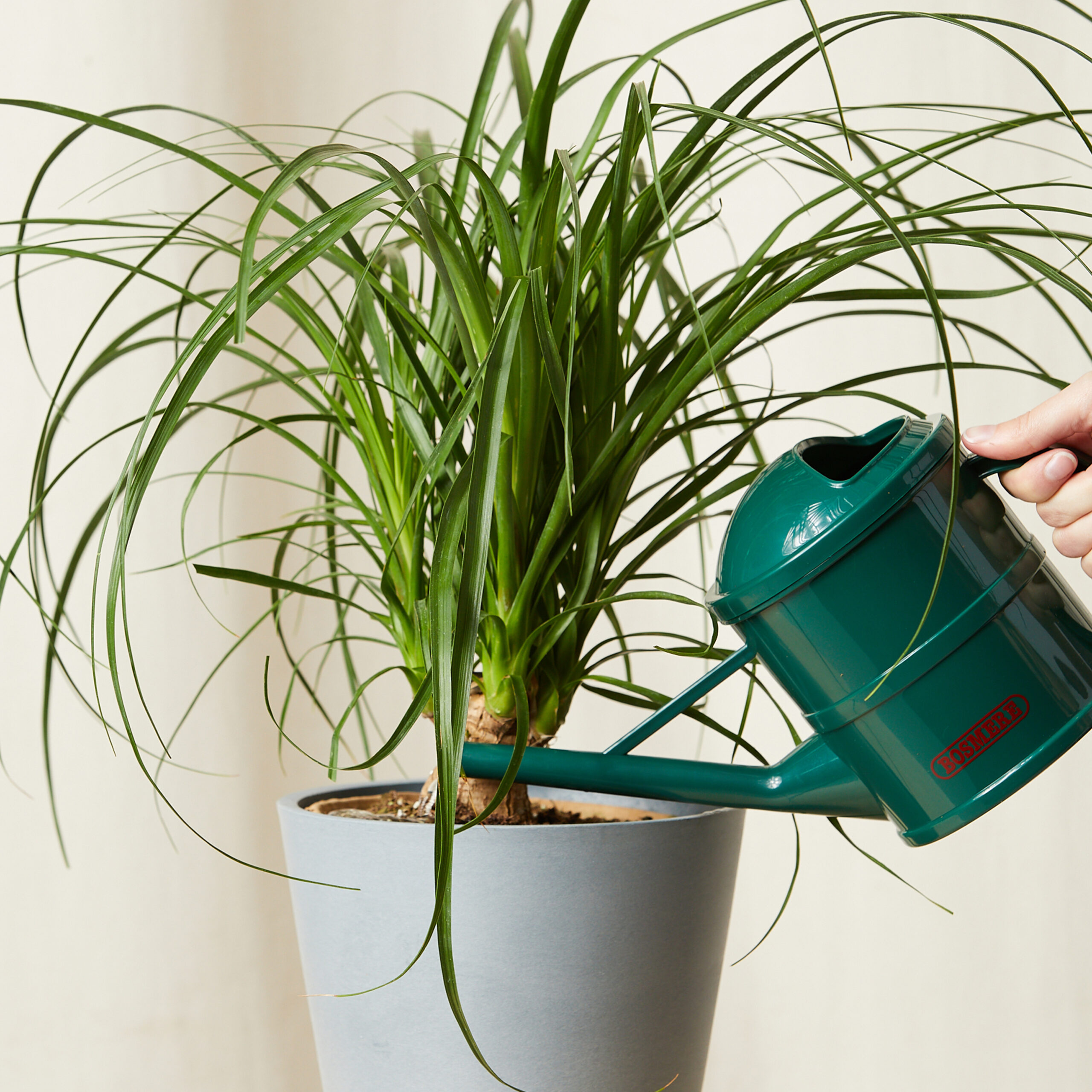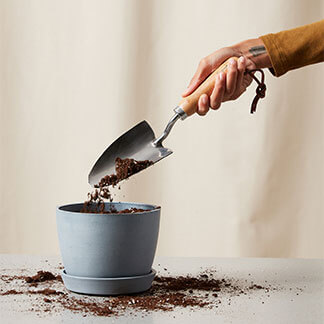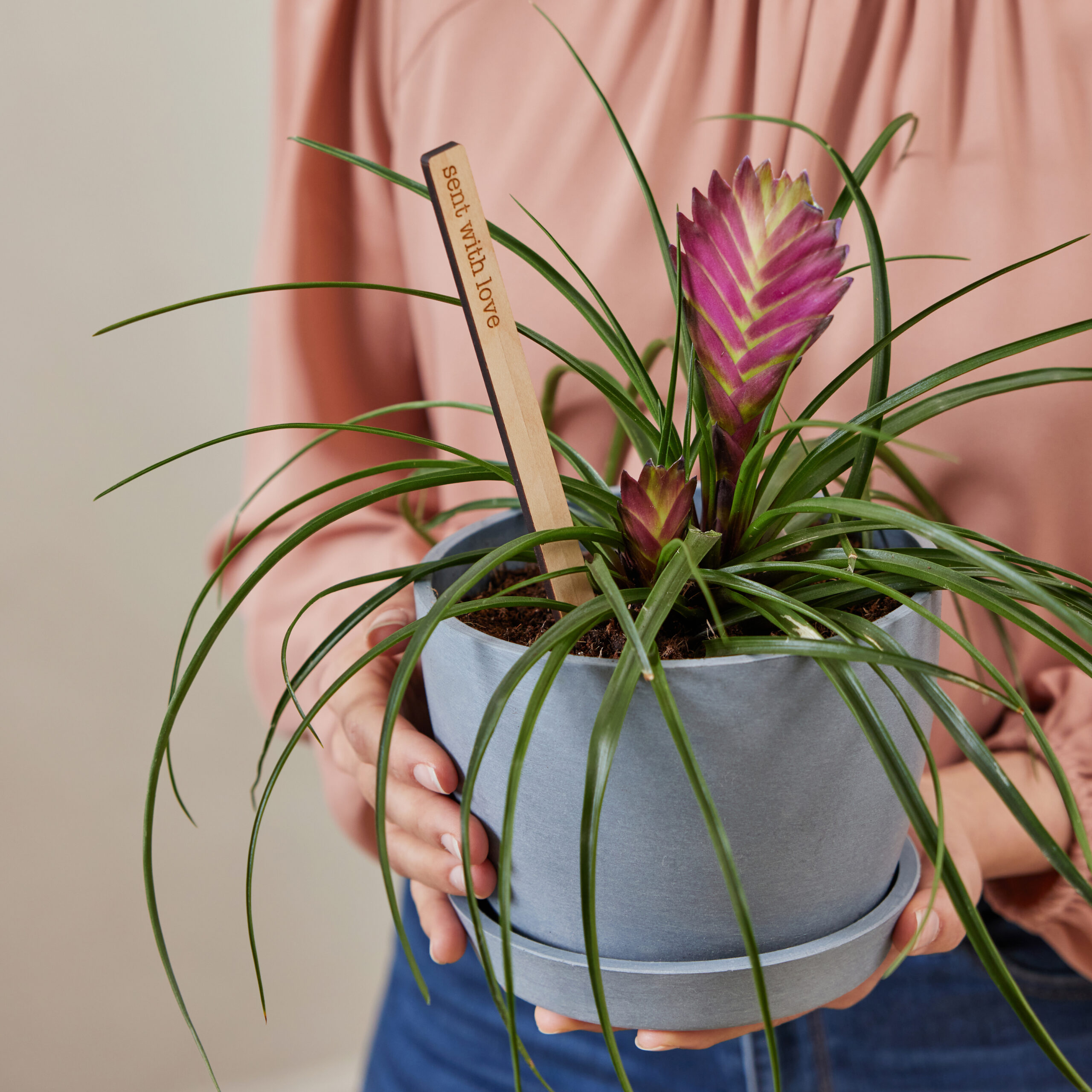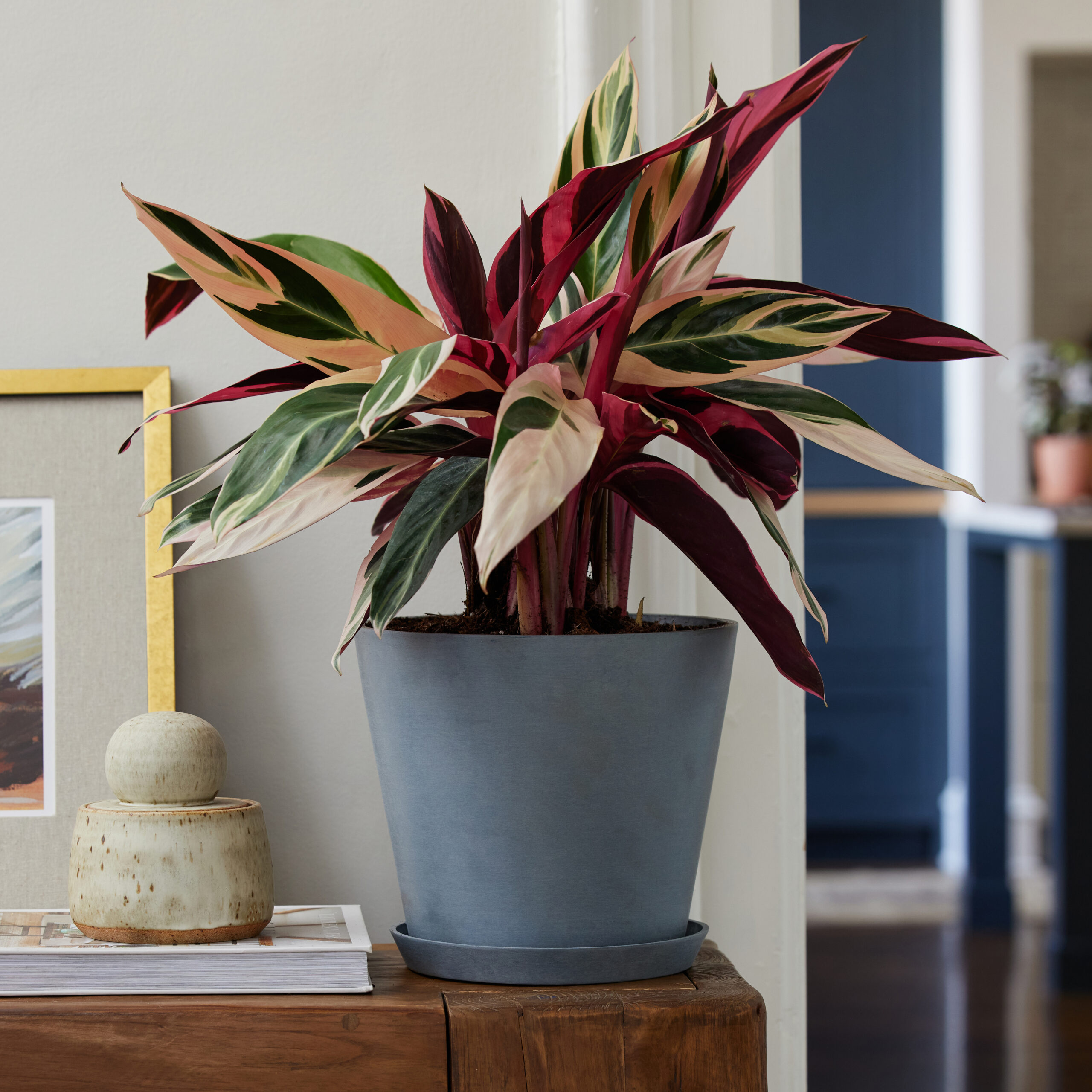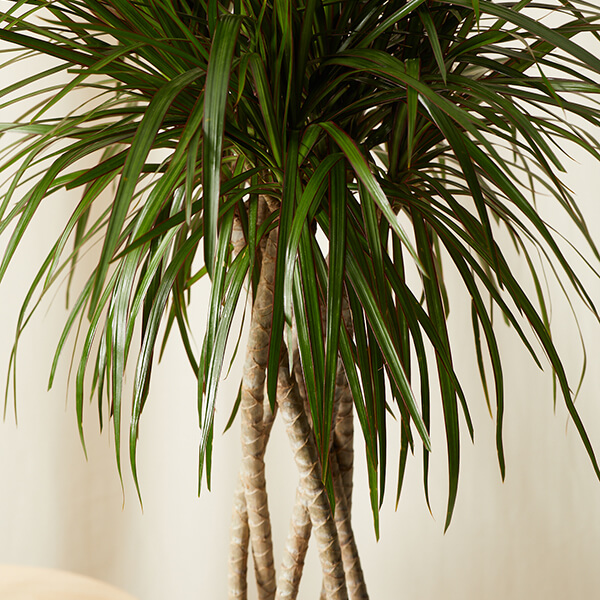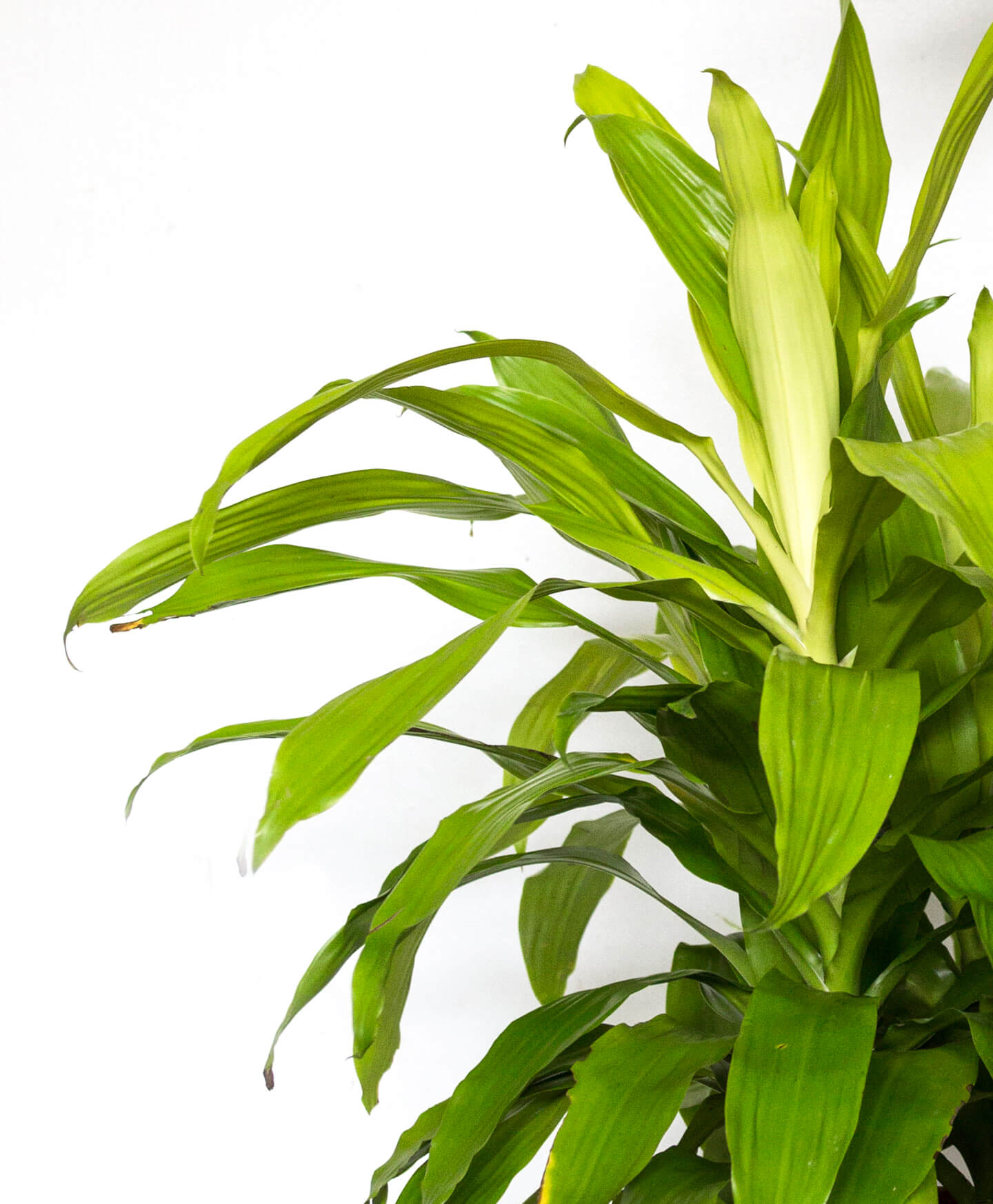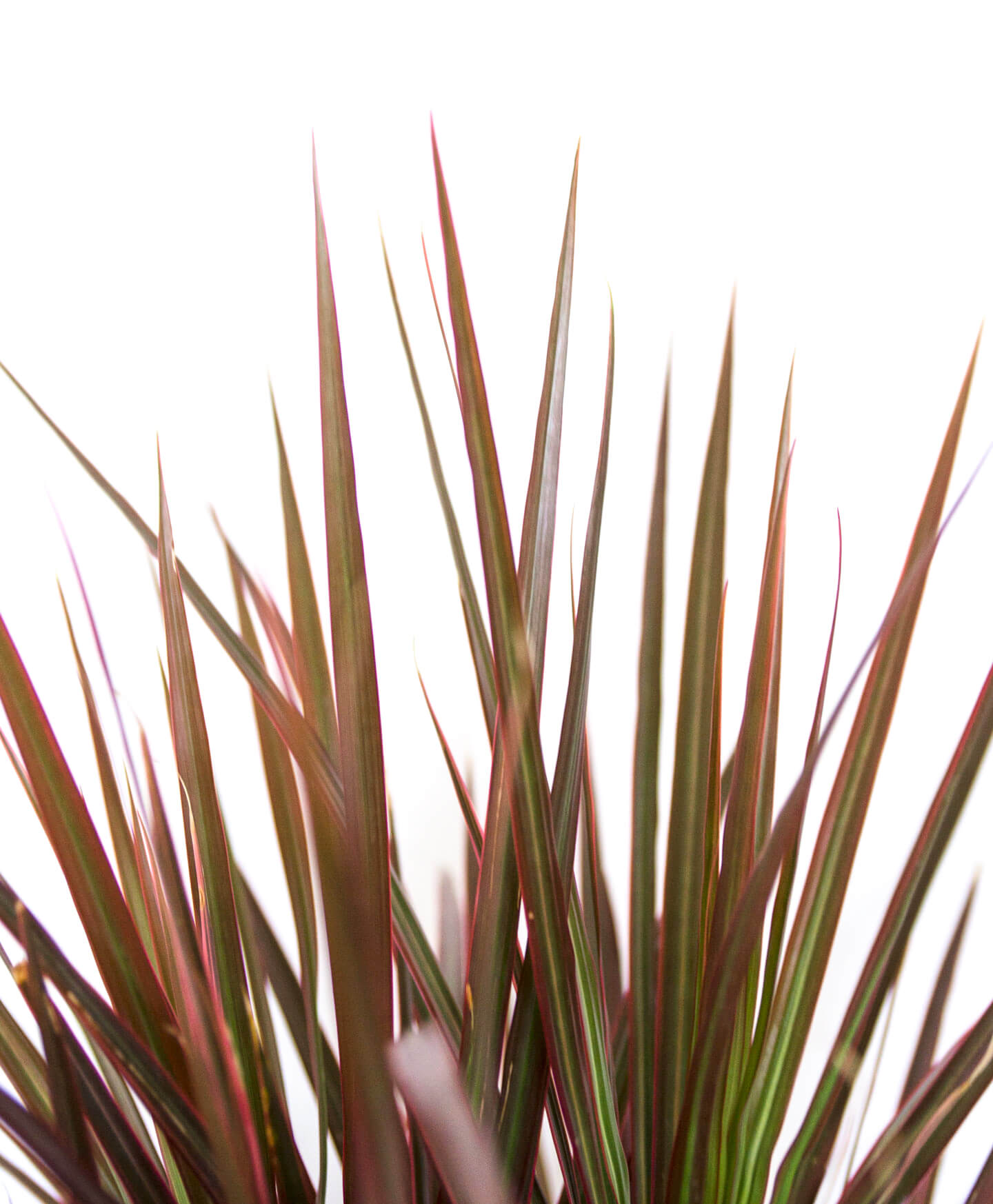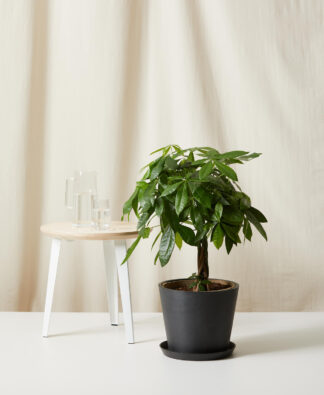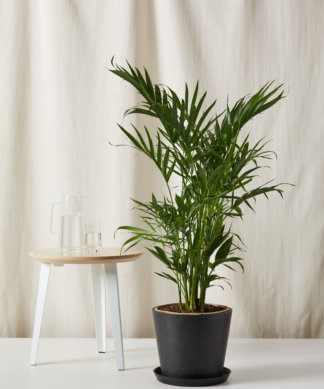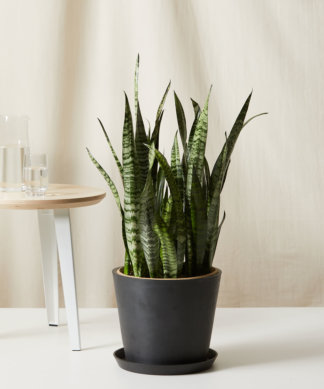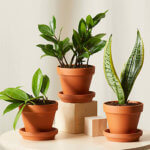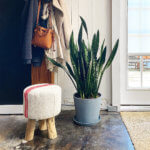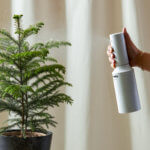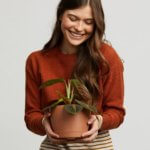How to care for your Dracaena
Use these instructions to care for a Dracaena. This guide will tell you how to water a Dracaena; its light, temperature, humidity preferences and any additional care it might need to help it grow.
Dracaena Colorama
Your Dracaena Colorama prefers medium indirect sunlight. Too much direct light can burn the leaves. Pale leaves, slow growth, and small new leaves indicate it is not getting enough light.
Water when the top 50%-75% of the soil is dry. Water until liquid flows through the drainage hole at the bottom of the pot and discard any water that has accumulated in the saucer.
Your Dracaena Colorama will do well in average humidity environments but will appreciate regular misting.
Your Dracaena likes comfortable room temperatures between 65-80 degrees. Do not allow the temperature to fall below 60 degrees.
This plant likes to be fed every two weeks in the spring and summer with a well-balanced plant food at half the recommended strength. No food is necessary during the winter when plant growth naturally slows. Always make sure the soil is damp before applying any fertilizer.
Dracaena Colorama leaves are toxic to pets and humans. Typically, ingestion will cause mouth and stomach irritation with possible vomiting.
Your Dracaena Colorama is sensitive to an excess of fluoride which is found in tap water and will present with brown or yellow margins of its leaves. If you do not have a filtration system, leaving the tap water in an open container overnight before watering can help remove some of the fluorides or use rainwater. When the plant begins to outgrow its space you can regulate the height by cutting off the top to the desired height. The tall, bare cane looks odd for a while, but within a few weeks, new shoots appear as the foliage begins to regrow.
Dracaena Dorado
Your Dracaena prefers bright indirect light but can adapt to low light. Too much direct sunlight can burn and bleach the leaves.
Water when the top 50%-75% of the soil is dry. Water until liquid flows through the drainage hole at the bottom of the pot and discard any water that has accumulated in the saucer.
Your Dracaena Dorado will thrive in average room temperatures, between 60-80 degrees.
Your Dracaena Dorado will benefit from a light misting 1-2 times per week, especially in the winter, when the air is dry. Misting also helps keep the foliage clean and dust-free.
Feed your Dracaena Dorado every month in the spring and summer with an all-purpose liquid fertilizer, diluted to half the recommended strength.
Moderately toxic to pets, typically causing mild mouth irritation, stomach irritation, and possible vomiting.
Look out for a common problem called ‘tipping’ when the tips of the leaves dry out and turn brown. The most common cause is tap water, which contains salts, chlorine, fluoride, and other elements that may be harmful in excess. To prevent this, you can use distilled water or rain water. Wipe the leaves with a soft damp cloth to remove dust as necessary. Take care to clean the undersides of the leaves as well as the upper surfaces. Removing dust opens the pores so your plant can exchange air freely, and it helps prevent pests from taking up residency.
Dracaena Elegance
Your dracaena can be placed in low to indirect light. Too little light and the foliage will yellow and growth will slow. Too much light and the foliage will burn.
Water when 75% of the soil volume is dry. The leading issue with dracaenas is root rot, so keep on the dry side. Always water until you see it flow out of the drainage hole and discard the excess water in the saucer.
Dracaenas do well in average household humidity.
Your Dracaena will thrive in average room temperatures, between 60-80°F.
The dracaena is slow-growing and does not need much fertilizer. Feed once a month in the spring and summer with general purpose plant food, diluted to half-strength. No fertilizer is necessary during the fall and winter when plant growth naturally slows. Always make sure the soil is damp before applying any fertilizer.
Dracaenas are toxic to humans and pets if ingested.
Look out for a common problem called ‘tipping’ when the tips of the leaves dry out and turn brown. The most common cause is tap water, which contains salts, chlorine, fluoride, and other elements that may be harmful in excess. To prevent this, you can use distilled water or rainwater.
Dracaena Fragrans
Your Dracaena Fragrans prefers medium to bright indirect sunlight but can survive in low light situations. Brown spots on the leaves or pale, bleached leaves usually indicate the plant is getting too much light. Leaves with less variegation, slow growth, and small new leaves indicate it is not getting enough light.
Water your plant thoroughly and allow the top 75% of the soil to dry before watering again. In low light, allow the soil to dry completely before watering. Water your plant less in the winter, when light levels are lower and growth has slowed. Overwatering will cause leaves to turn yellow and fall off, as well as root rot, and the eventual death of the plant.
Your Dracaena will do well in average humidity environments but will appreciate regular misting.
This plant likes average room temperatures between 65-80 degrees. They do not do well in temperatures below 55 degrees. Cold winter drafts and blowing heaters can damage the leaves.
Dracaena Fragrans needs very little plant food. Feed once or twice a year in the spring and summer with a basic houseplant food diluted to half the recommended strength. Too much fertilizer can cause the leaf tips to burn.
Dracaena Fragrans leaves are toxic to pets and humans. Typically, ingestion will cause mouth and stomach irritation with possible vomiting.
If you find the tips of your Dracaena’s leaves begin to turn brown, it may be caused by chemicals in your tap water. Use filtered water, or leave tap water in an open container overnight before watering to allow some of the chemicals to evaporate.
Dracaena Giganta
Your Dracaena Giganta will tolerate low light but will thrive in medium and indirect light. Do not put your Giganta in hot direct sunlight as it will scorch the leaves. If it is not receiving sufficient light, the newer leaves will narrow.
Water when the top 50%-75% of the soil is dry. Water until liquid flows through the drainage hole at the bottom of the pot and discard any water that has accumulated in the saucer.
Your Dracaena will benefit from a light misting 1-2 times per week, especially in the winter, when the air is dry. Misting also helps keep the foliage clean and dust-free.
The ideal temperature for your Giganta is between 65-75 degrees.
Feed your Giganta monthly during the spring through fall with a liquid houseplant fertilizer diluted to half the recommended strength.
Your Giganta is moderately toxic, typically causing mild mouth irritation, stomach indigestion, and possible vomiting if ingested.
Look out for a common problem called ‘tipping’ when the tips of the leaves dry out and turn brown. The most common cause is tap water, which contains salts, chlorine, fluoride, and other elements that may be harmful in excess. To prevent this, you can use distilled water or rainwater. Wipe the leaves with a soft damp cloth to remove dust as necessary. Take care to clean the undersides of the leaves as well as the upper surfaces. Removing dust opens the pores so your plant can exchange air freely, and it helps prevent pests from taking up residency.
Dracaena Gold Star
Your Dracaena Gold Star prefers bright indirect light but can survive in low light. Leaves with less variegation, slow growth, and small new leaves indicate it is not getting enough light. Too much direct sunlight will burn the leaves.
Water when the top 75% of the soil is dry. Water until liquid flows through the drainage hole at the bottom of the pot and discard any water that has accumulated in the saucer.
Your Dracaena Gold Star will do well in average humidity environments but will appreciate regular misting.
Your Dracaena prefers room temperatures between 65-80 degrees. They do not do well in temperatures below 55 degrees. Cold winter drafts and blowing heaters can damage the leaves.
Feed once a month during the spring and summer with a liquid fertilizer for indoor plants.
Dracaena leaves are toxic to pets and humans. Typically, ingestion will cause mouth and stomach irritation with possible vomiting.
Look out for a common problem called ‘tipping’ when the tips of the leaves dry out and turn brown. The most common cause is tap water, which contains salts, chlorine, fluoride, and other elements that may be harmful in excess. To prevent this, you can use distilled water or rain water.
Dracaena Golden Heart
Your Dracaena Golden Heart does best in low to indirect bright light. Direct sunlight can cause the variegation to fade and can scorch the leaves.
Water when 75% of the soil volume is dry. Water until liquid flows through the drainage hole at the bottom of the pot and discard any water that has accumulated in the saucer.
Your Dracaena will do well in average household humidity.
Your Dracaena likes comfortable room temperatures between 65-80°F.
Feed your Dracaena once a month during the spring and summer with an all-purpose fertilizer for indoor plants. Always make sure the soil is damp before applying any fertilizer.
Dracaena Golden Heart leaves are considered toxic to pets and humans if ingested.
Look out for a common problem called ‘tipping’ when the tips of the leaves dry out and turn brown. The most common cause is tap water, which contains salts, chlorine, fluoride, and other elements that may be harmful in excess. To prevent this, you can use distilled water or rainwater.
Dracaena Green Jewel
Your Dracaena Green Jewel prefers bright indirect sunlight but can survive in low-light situations. Pale bleached leaves usually indicate the plant is getting too much light. Slow growth and small new leaves indicate it is not getting enough light.
Water when the top 75% of the soil is dry. Water until liquid flows through the drainage hole at the bottom of the pot and discard any water that has accumulated in the saucer.
Your Green Jewel will do well in average humidity environments but will appreciate regular misting.
This plant likes average room temperatures between 65-80 degrees. They do not do well in temperatures below 55 degrees. Cold winter drafts and blowing heaters can damage the leaves.
Feed once a month during the spring and summer with a liquid fertilizer for indoor plants.
Dracaena Green Jewel leaves are toxic to pets and humans. Typically, ingestion will cause mouth and stomach irritation with possible vomiting.
If you find the tips of your Dracaena’s leaves begin to turn brown, it may be caused by chemicals in your tap water. Use filtered water, rainwater, or leave tap water in an open container overnight before watering to allow some of the chemicals to evaporate.
Dracaena Jade Jewel
Your Dracaena Jade Jewel prefers medium indirect sunlight but can survive in low-light situations. Pale bleached leaves usually indicate the plant is getting too much light. Leaves with less variegation, slow growth, and small new leaves indicate it is not getting enough light.
Water when the top 75% of the soil is dry. Water until liquid flows through the drainage hole at the bottom of the pot and discard any water that has accumulated in the saucer.
Your Jade Jewel will do well in average humidity environments but will appreciate regular misting.
This plant likes average room temperatures between 65-80 degrees. They do not do well in temperatures below 55 degrees. Cold winter drafts and blowing heaters can damage the leaves.
Feed once a month during the spring and summer with a liquid fertilizer for indoor plants.
Dracaena Jade Jewel leaves are toxic to pets and humans. Typically, ingestion will cause mouth and stomach irritation with possible vomiting.
Look out for a common problem called ‘tipping,’ when the tips of the leaves dry out and turn brown. This can be caused by a variety of issues like overwatering or fertilizer burn. The most common cause is tap water, which contains salts, chlorine, fluoride, and other elements that may be harmful if built up in the soil. If you do not have a filtration system, leaving the tap water in an open container overnight before watering can help remove some of the chlorine and fluoride or you can use rainwater.
Dracaena Janet Craig
Your Dracaena Janet Craig prefers medium indirect sunlight but can survive in low-light situations. Pale bleached leaves usually indicate the plant is getting too much light. Pale leaves, slow growth, and small new leaves indicate it is not getting enough light.
Water when the top 75% of the soil is dry. Water until liquid flows through the drainage hole at the bottom of the pot and discard any water that has accumulated in the saucer.
Your Dracaena Janet Craig will do well in average humidity environments but will appreciate regular misting.
Your Dracaena Janet Craig likes comfortable room temperatures between 65-80 degrees. They do not do well in temperatures below 55 degrees. Cold winter drafts and blowing heaters will damage the leaves.
Dracaena Janet Craig needs very little plant food. Feed once or twice a year in the spring and summer with a basic houseplant food at half the recommended strength. Too much fertilizer will cause the leaf tips to burn.
Dracaena Janet Craig leaves are toxic to pets and humans. Typically, ingestion will cause mouth and stomach irritation with possible vomiting.
Look out for a common problem called ‘tipping’ when the tips of the leaves dry out and turn brown. This can be caused by a variety of issues like overwatering, too much fertilizer, etc. The most common cause is tap water, which contains salts, chlorine, and fluoride. If you do not have a filtration system, leaving the tap water in an open container overnight before watering can help remove some of the chlorine and fluoride or use rainwater.
Dracaena Lemon Lime
Your Dracaena Lemon Lime prefers medium indirect sunlight but can survive in low-light situations. Pale bleached leaves usually indicate the plant is getting too much light. Pale leaves, slow growth, and small new leaves indicate it is not getting enough light.
Water when the top 75% of the soil is dry. Water until liquid flows through the drainage hole at the bottom of the pot and discard any water that has accumulated in the saucer.
Your Dracaena does not require any additional humidity but will enjoy occasional misting.
Your Dracaena prefers temperatures between 60-75 degrees.
Feed once a month during the spring and summer with a liquid fertilizer for indoor plants.
Not toxic to humans. Moderately toxic to pets, typically causing mild mouth irritation, stomach indigestion, and possible vomiting.
Look out for a common problem called ‘tipping’ when the tips of the leaves dry out and turn brown. This can be caused by a variety of issues like overwatering, too much fertilizer, etc. The most common cause is tap water, which contains salts, chlorine, and fluoride. If you do not have a filtration system, leaving the tap water in an open container overnight before watering can help remove some of the chlorine and fluoride or use rainwater.
Dracaena Limelight
Your Dracaena Limelight does best in low to indirect bright light. Direct sunlight can cause the lime color to fade and can even scorch the leaves.
Water your Dracaena when 75% of the soil volume is dry. Always water thoroughly and discard excess water in the saucer to avoid root rot. Overwatering causes root rot and is the most common reason a Dracaena plant dies.
Your Dracaena will do well in average household humidity.
Your Dracaena likes comfortable room temperatures between 65-80°F.
The Dracaena is slow-growing and does not need much fertilizer. Feed once a month in the spring and summer with an all-purpose plant food, diluted to half-strength. No fertilizer is necessary during the fall and winter when plant growth naturally slows. Always make sure the soil is damp before applying any fertilizer.
Dracaena Limelight leaves are toxic to pets and humans if ingested.
Look out for a common problem called ‘tipping’ when the tips of the leaves dry out and turn brown. The most common cause is tap water, which contains salts, chlorine, fluoride, and other elements that may be harmful in excess. To prevent this, you can use distilled water or rainwater.
Dracaena Magenta Braid
Your Dracaena will do best in medium to bright indirect sunlight, but can tolerate low light.
Overwatering causes root rot and is the main reason a Dracaena plant dies. Water your Dracaena well and allow the top 50-75% of the soil to dry before watering again. Brown tips on the leaves can indicate over watering while numerous yellow leaves mean the plant needs more water.
Your Dracaena will do well in average humidity environments, but will appreciate regular misting.
Dracaenas like average room temperatures between 65-85°F.
Dracaena plants are slow-growing and do not need much fertilizer. Feed once a month in the spring and summer with an all-purpose plant food at half the recommended strength. No fertilizer is necessary during the fall and winter when plant growth naturally slows.
Dracaena is toxic to pets and humans. Typically, ingestion will cause mouth and stomach irritation with possible vomiting.
Look out for a common problem called ‘tipping’ when the tips of the leaves dry out and turn brown. The most common cause is tap water, which contains salts, chlorine, fluoride, and other elements that may be harmful in excess. To prevent this, you can use distilled water or rain water.
Dracaena Marginata Bush
Your Dracaena Marginata prefers medium indirect sunlight but can survive in low light situations. Bleached leaves with dry brown spots usually indicate the plant is getting too much light. Pale leaves, slow growth, and small new leaves indicate it is not getting enough light.
Overwatering causes root rot and is the main reason a Dracaena Marginata plant dies. Water your Marginata well and allow the top 75% of the soil to dry before watering again.
Your Dracaena Marginata will do well in average humidity environments but will appreciate regular misting.
Marginatas like comfortable room temperatures between 65-80 degrees.
Feed once a month during the spring and summer with a liquid fertilizer for indoor plants. No fertilizer is necessary during the winter when plant growth naturally slows.
Dracaena Marginata leaves are toxic to pets and humans. Typically, ingestion will cause mouth and stomach irritation with possible vomiting.
Look out for a common problem called ‘tipping’ when the tips of the leaves dry out and turn brown. This can be caused by a variety of issues like overwatering, too much fertilizer, etc. The most common cause is tap water, which contains salts, chlorine, and fluoride. If you do not have a filtration system, leaving the tap water in an open container overnight before watering can help remove some of the chlorine and fluoride or you can use rainwater.
Dracaena Marginata Open Weave
Your Dracaena Marginata prefers medium indirect sunlight but can survive in low-light situations. Pale bleached leaves usually indicate the plant is getting too much light. Pale leaves, slow growth, and small new leaves indicate it is not getting enough light.
Overwatering causes root rot and is the main reason a Dracaena Marginata plant dies. Water your Marginata well and allow the top 75% of the soil to dry before watering again.
Your Dracaena Marginata will do well in average humidity environments but will appreciate regular misting.
Marginatas like comfortable room temperatures between 65-80 degrees.
Feed once a month during the spring and summer with a liquid fertilizer for indoor plants. No fertilizer is necessary during the winter when plant growth naturally slows.
Dracaena Marginata leaves are toxic to pets and humans. Typically, ingestion will cause mouth and stomach irritation with possible vomiting.
Look out for a common problem called ‘tipping’ when the tips of the leaves dry out and turn brown. This can be caused by a variety of issues like overwatering, too much fertilizer, etc. The most common cause is tap water, which contains salts, chlorine, and fluoride. If you do not have a filtration system, leaving the tap water in an open container overnight before watering can help remove some of the chlorine and fluoride or use rainwater.
Dracaena Rikki Cane
Your dracaena can be placed in low to indirect light. Too little light and the foliage will yellow and growth will slow. Too much light and the foliage will burn.
Water when 75% of the soil volume is dry. The leading issue with dracaenas is root rot, so keep on the dry side. Always water until you see it flow out of the drainage hole and discard the excess water in the saucer.
Dracaenas do well in average household humidity.
Your Dracaena will thrive in average room temperatures, between 60-80°F.
The dracaena is slow-growing and does not need much fertilizer. Feed once a month in the spring and summer with general purpose plant food, diluted to half-strength. No fertilizer is necessary during the fall and winter when plant growth naturally slows. Always make sure the soil is damp before applying any fertilizer.
Dracaenas are toxic to humans and pets if ingested.
Look out for a common problem called ‘tipping’ when the tips of the leaves dry out and turn brown. The most common cause is tap water, which contains salts, chlorine, fluoride, and other elements that may be harmful in excess. To prevent this, you can use distilled water or rainwater.
Dracaena Sol
Your Dracaena Sol prefers bright indirect light but can survive in low light. Leaves with less variegation, slow growth, and small new leaves indicate it is not getting enough light.
Overwatering causes root rot and is the main reason a dracaena plant dies. Water your plant thoroughly and allow the top 75% of the soil to dry before watering again. In low light, allow the soil to dry completely before watering. Water your plant less in the winter, when light levels are lower and growth has slowed.
Your Dracaena Sol will do well in average humidity environments but will appreciate regular misting.
Your dracaena prefers room temperatures between 65-80°F. They do not do well in temperatures below 55°F. Cold winter drafts and blowing heaters can damage the leaves.
Your dracaena needs very little plant food. Feed twice a year in the spring and summer with liquid houseplant food at half the recommended strength.
Dracaena leaves are toxic to pets and humans. Typically, ingestion will cause mouth and stomach irritation with possible vomiting.
Look out for a common problem called ‘tipping’ when the tips of the leaves dry out and turn brown. The most common cause is tap water, which contains salts, chlorine, fluoride, and other elements that may be harmful in excess. To prevent this, you can use distilled water or rainwater.
Dracaena Song of India
Your Dracaena Song of India prefers bright, indirect sunlight, but can survive in low light situations.
Water your Song of India thoroughly and allow 50–75% of the soil to dry before watering again. In low light, allow the soil to dry completely before watering. Water your plant less in the winter, when light levels are lower and growth has slowed. Overwatering will cause leaves to turn yellow and fall off, as well as root rot, and the eventual death of the plant.
Your Dracaena Song of India will do well in average humidity environments but will appreciate regular misting.
Song of Indias like average room temperatures between 65–80 degrees.
Feed once a month during the spring and summer with a liquid fertilizer for indoor plants. No fertilizer is necessary during the winter when plant growth naturally slows.
Dracaena Song of India leaves are toxic to pets and humans. Typically, ingestion will cause mouth and stomach irritation with possible vomiting.
Look out for a common problem called ‘tipping’ when the tips of the leaves dry out and turn brown. This can be caused by a variety of issues like overwatering or fertilizer burn. The most common cause is tap water, which contains salts, chlorine, fluoride, and other elements that may be harmful if built up in the soil. If you do not have a filtration system, leaving the tap water in an open container overnight before watering can help remove some of the chlorine or fluoride or you can use rainwater.
Dracaena Song of Jamaica
Your Dracaena Song of Jamaica prefers bright indirect sunlight, but can survive in medium to low light situations.
Water your Song of Jamaica thoroughly and allow 50-75% of the soil to dry before watering again. Overwatering causes root rot and is the main reason a Dracaena Song of Jamaica plant dies. Yellow leaves indicate that the plant is being kept too wet.
Your Dracaena Song of Jamaica will do well in average humidity environments, but will appreciate regular misting.
Your Song of Jamaica likes average room temperatures between 65-80 degrees.
Feed once a month during the spring and summer with a liquid fertilizer for indoor plants. No fertilizer is necessary during the winter when plant growth naturally slows.
Dracaena Song of Jamaica leaves are toxic to pets and humans. Typically, ingestion will cause mouth and stomach irritation with possible vomiting.
Look out for a common problem called ‘tipping’ when the tips of the leaves dry out and turn brown. This can be caused by a variety of issues like overwatering, too much fertilizer, etc. The most common cause is tap water, which contains salts and excess minerals. If you do not have a filtration system, leaving the tap water in an open container overnight before watering can help remove some of these minerals or you can use rainwater.
Dracaena Tarzan
Your Dracaena Tarzan will do best in medium to bright indirect sunlight, but can tolerate low light.
Overwatering causes root rot and is the main reason a Dracaena plant dies. Water your Dracaena well and allow the top 75% of the soil to dry before watering again. Water thoroughly and discard any excess water.
Your Dracaena Tarzan will do well in average humidity environments, but will appreciate regular misting.
Dracaenas like average room temperatures between 65-85°F.
Dracaena plants are slow-growing and do not need much fertilizer. Feed once a month in the spring and summer with an all-purpose plant food at half the recommended strength. No fertilizer is necessary during the winter when plant growth naturally slows.
Dracaena leaves are toxic to pets and humans. Typically, ingestion will cause mouth and stomach irritation with possible vomiting.
Look out for a common problem called ‘tipping’ when the tips of the leaves dry out and turn brown. The most common cause is tap water, which contains salts, chlorine, fluoride, and other elements that may be harmful in excess. To prevent this, you can use distilled water or rain water.
Dracaena Twister
Your Dracaena Twister prefers medium indirect sunlight but can survive in low-light situations. Pale bleached leaves usually indicate the plant is getting too much light. Slow growth and small new leaves indicate it is not getting enough light.
Water when the top 50%-75% of the soil is dry. Water until liquid flows through the drainage hole at the bottom of the pot and discard any water that has accumulated in the saucer. Overwatering will cause leaves to turn yellow and fall off. Overwatering causes root rot and is the main reason a Dracaena plant dies.
Your Dracaena Twister will do well in average humidity household humidity but will appreciate regular misting.
This plant likes normal room temperatures between 65-80 degrees. They do not do well in temperatures below 55 degrees. Cold winter drafts and blowing heaters can damage the leaves.
Feed your Dracaena Twister every month in the spring and summer with an all-purpose liquid fertilizer, diluted to half the recommended strength.
Dracaena Twister leaves are toxic to pets and humans. Typically, ingestion will cause mouth and stomach irritation with possible vomiting.
Look out for a common problem called ‘tipping,’ when the tips of the leaves dry out and turn brown. This can be caused by a variety of issues like overwatering or fertilizer burn, but the most common cause is tap water. Tap water contains salts, chlorine, fluoride, and other elements that may build up in the soil over time. If you do not have a filtration system, leaving your tap water in an open container overnight before watering can help remove some of the chlorine and fluoride or use rainwater.
Dracaena Warneckii
Your dracaena can be placed in low to indirect light. Too little light and the foliage will yellow and growth will slow. Too much light and the foliage will burn.
Water when 75% of the soil volume is dry. The leading issue with dracaenas is root rot, so keep on the dry side. Always water until you see it flow out of the drainage hole and discard the excess water in the saucer.
Dracaenas do well in average household humidity.
Your Dracaena will thrive in average room temperatures, between 60-80°F.
The dracaena is slow-growing and does not need much fertilizer. Feed once a month in the spring and summer with an all-purpose plant food, diluted to half-strength. No fertilizer is necessary during the fall and winter when plant growth naturally slows. Always make sure the soil is damp before applying any fertilizer.
Dracaena Warneckii leaves are toxic to pets and humans if ingested.
Look out for a common problem called ‘tipping’ when the tips of the leaves dry out and turn brown. The most common cause is tap water, which contains salts, chlorine, fluoride, and other elements that may be harmful in excess. To prevent this, you can use distilled water or rainwater.
Lucky Bamboo
Your Lucky Bamboo loves to bask in bright indirect or filtered sunlight but can survive in low-light situations. Pale bleached leaves usually indicate the plant is getting too much light. Slow growth and small new leaves indicate it is not getting enough light.
Since your Lucky Bamboo would be happy sitting in a pot of pebbles with water covering its roots. You can add water every couple of days, but remember to change the water weekly to avoid odor and disease. If you’re growing your Lucky Bamboo in potting soil, water your plant once a week until the soil is moist but not soggy. Another important tip is to use bottled or distilled water since the plant is sensitive to the chlorine found in tap water.
Your Lucky Bamboo thrives in average household humidity levels. So you don’t have to take extra steps to add moisture to the air.
Your Lucky Bamboo is perfectly content in warm temperatures that range between 65-95° F. Remember to keep your plant away from vents and drafts.
Your Lucky Bamboo is not a hefty eater. You can fertilize once in the early spring with a plant food high in nitrogen. All it takes is one drop if you’re using a liquid formula.
Your Lucky Bamboo is toxic to pets and humans. Typically, ingestion will cause mouth and stomach irritation with possible vomiting.
You can propagate your lucky bamboo by taking healthy stem cuttings at any point during the year. If you find the tips of your Lucky Bamboo’s leaves begin to turn brown, it may be caused by chemicals in your tap water. Use filtered water, rainwater, or leave tap water in an open container overnight before watering to allow some of the chemicals to evaporate.
